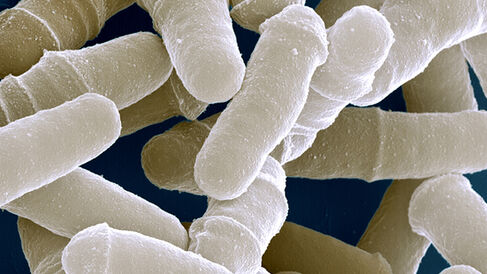
The Mata Group, and collaborators from University College London, have published a new paper in the journal PNAS.
Proteins are large biological molecules consisting of one or more chains of amino acid building blocks that perform a vast array of functions within all life. In the broadest of terms, the process through which cells create proteins from instructions encoded within genes in their DNA consists of two main stages. In the first stage, called transcription, the enzyme RNA polymerase uses DNA as a template to make an mRNA (messenger RNA) complementary copy of a gene. mRNA then leaves the nucleus and enters the cell's cytoplasm to associate with a ribosome; the complex molecular machine where protein synthesis takes place. In this second stage, called translation, the ribosome 'reads' the genetic information in the mRNA molecule, allowing tRNAs (transfer RNAs) to bring amino acids into the ribosome in the specific order necessary to form the required protein. The amino acids are then joined together through peptide bonds, creating a polypeptide chain that will later fold into an active protein.
Under conditions of stress, such as starvation or extremes of temperature, cells require different proteins to be synthesised than normal in order to aid and promote their survival. One of the best-studied stress conditions is amino acid starvation. Here, the lack of protein building blocks leads to free tRNA molecules that are not bound to an amino acid. These free tRNAs activate a signalling pathway that switches off 'normal' gene expression and turns on the synthesis of 'survival' proteins. This altered programme of gene expression that promotes cell survival under stress is called general amino acid control (GAAC) in yeast and the amino acid response (AAR) in mammals.1-3
The changes in gene expression during GAAC/AAR, resulting from amino acid starvation, are specifically mediated by Gcn2 proteins.4 Under normal conditions translation initiation factor eIF2 brings the first tRNA into a ribosome to begin the process of translation. During amino acid starvation, however, free tRNAs activate Gcn2 to inhibit eIF2, thus causing global translation down-regulation.5 In addition to switching off 'normal' gene expression, this global reduction in translation also switches off repressive translation events that would usually prevent the synthesis of a subset of proteins; the 'survival' proteins required during stress conditions. These 'survival' proteins are therefore only produced by cells following the reduction in translation as a response to amino acid starvation. In the budding yeast, Saccharomyces cerevisiae, the key 'survival' protein for GAAC is the transcription factor Gcn4, whilst in mammals AAR is mediated by Atf4. Although Gcn4 and Atf4 are both b-ZIP transcription factors and are functional homologs, they are not direct orthologs (descendants of the same ancestral gene).2,6-7
Like budding yeast, the fission yeast Schizosaccharomyces pombe responds to amino acid starvation through GAAC and the Gcn2-eIF2 signalling pathway. Fission yeast, however, lack a clear Gcn4/Atf4 ortholog, and the key 'survival' protein for amino acid starvation has yet to be identified.8
In their new paper, Duncan et al. use ribosome profiling and parallel mRNA sequencing to investigate the translational response of fission yeast to amino acid starvation. Their genome-wide analysis identified a transcription factor called Fil1 as a functional homolog of Gcn4; both proteins are essential for GAAC to promote expression of genes involved in amino acid biosynthesis, and both are regulated at the translational level through repressive translation events by a similar mechanism. Despite these functional homologies, Fil1 and Gcn4 show no sequence homology as they belong to different families of transcription factors. This is surprising, as the Gcn2-eIF2 signalling pathway is one of the most conserved in eukaryotic cells. These results suggest that extensive rewiring of the cellular response to amino acid starvation has taken place during the evolution of this key pathway, with completely different transcription factors performing the same functions in different organisms. This is a striking example of the plasticity of gene expression programmes, where function and regulation can be maintained using non-conserved transcription factors.
1Spriggs et al., Mol. Cell40:228 (2010).
2Hinnebusch, Annu. Rev. Microbiol. 59:407 (2005).
3Kilberg et al., Adv. Nutr.3:295 (2012).
4Castilho et al., Biochim. Biophys. Acta.1843:1948 (2014).
5Dever et al., Genetics203:65 (2016).
6Jackson et al., Nat. Rev. Mol. Cell Biol.11:113 (2010).
7Sundaram and Grant, RNA 20:559 (2014).
8Udagawa et al., J. Biol. Chem. 283:22063 (2008).
